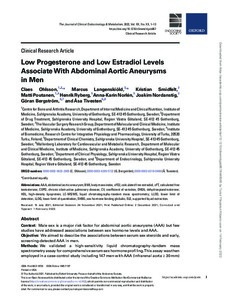Low Progesterone and Low Estradiol Levels Associate with Abdominal Aortic Aneurysms in Men
Norlén Anna-Karin; Ohlsson Claes; Smidfelt Kristian; Langenskiöld Marcus; Bergström Göran; Nordanstig Joakim; Ryberg Henrik; Poutanen Matti; Tivesten Åsa
https://urn.fi/URN:NBN:fi-fe2022021519188
Tiivistelmä
Context
Male sex is a major risk factor for abdominal aortic aneurysms (AAA) but few studies have addressed associations between sex hormone levels and AAA.
Objective
To describe the associations between serum sex steroids and early, screening-detected AAA in men.
Methods
We validated a high-sensitivity liquid chromatography-tandem mass spectrometry assay for comprehensive serum sex hormone profiling. This assay was then employed in a case-control study including 147 men with AAA (infrarenal aorta ≥30 mm) and 251 AAA-free controls recruited at the general population-based ultrasound screening for AAA in 65-year-old Swedish men.
Outcomes included
Associations between dehydroepiandrosterone, progesterone, 17α-hydroxyprogesterone, androstenedione, estrone, testosterone, dihydrotestosterone, and estradiol and AAA presence.
Results
Dehydroepiandrosterone, progesterone, 17α-hydroxyprogesterone, testosterone, and estradiol, but not the other hormones, were lower in men with AAA. In models with adjustments for known AAA risk factors and comorbidity, only progesterone (odds ratio per SD decrease 1.62 [95% CI 1.18-2.22]) and estradiol (1.40 [95% CI 1.04-1.87]) remained inversely associated with the presence of AAA. Progesterone and estradiol contributed with independent additive information for prediction of AAA presence; compared with men with high (above median) levels, men with low (below median) levels of both hormones had a 4-fold increased odds ratio for AAA (4.06 [95% CI 2.25-7.31]).
Conclusion
Measured by a high-performance sex steroid assay, progesterone and estradiol are inversely associated with AAA in men, independently of known risk factors. Future studies should explore whether progesterone and estradiol, which are important reproductive hormones in women, are protective in human AAA.
Kokoelmat
- Rinnakkaistallenteet [19207]
